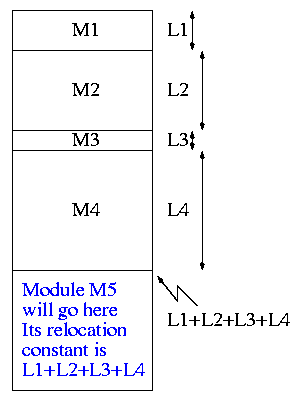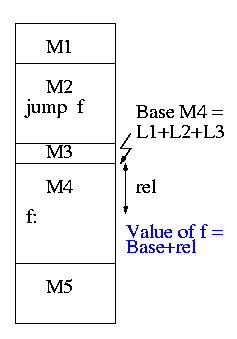Start Lecture #1
I start at -1 so that when we get to chapter 1, the numbering will agree with the text.
There is a web site for the course. You can find it from my home page, which is http://cs.nyu.edu/~gottlieb
The course text is Tanenbaum, "Modern Operating Systems", Third Edition (3e).
Replyto contribute to the current thread, but NOT to start another topic.
top post, that is, when replying, either place you reply after the original text or interspersed with it. I know that there are differing opinions on top posting, but I find it very hard to follow conversations that way.
Grades will computed as 30%*LabAverage + 30% MidtermExam + 40%*FinalExam (but see homeworks below).
I use the upper left board for lab/homework assignments and announcements. I should never erase that board. Viewed as a file it is group readable (the group is those in the room), appendable by just me, and (re-)writable by no one. If you see me start to erase an announcement, let me know.
I try very hard to remember to write all announcements on the upper left board and I am normally successful. If, during class, you see that I have forgotten to record something, please let me know. HOWEVER, if I forgot and no one reminds me, the assignment has still been given.
I make a distinction between homeworks and labs.
Labs are
Homeworks are
Homeworks are numbered by the class in which they are assigned. So any homework given today is homework #1. Even if I do not give homework today, the homework assigned next class will be homework #2. Unless I explicitly state otherwise, all homeworks assignments can be found in the class notes. So the homework present in the notes for lecture #n is homework #n (even if I inadvertently forgot to write it to the upper left board).
You may solve lab assignments on any system you wish, but ...
request receiptfeature from home.nyu.edu or mail.nyu.edu and select the
when deliveredoption.
I sent it ... I never received itdebate. Thank you.
Good methods for obtaining help include
The department wishes to reinforce the knowledge of C learned in 201. As a result, lab #2 must be written in C. The other labs may be written in C or Java. C++ is permitted (and counts as C for lab2); however, C++ is a complicated language and I advise against using it unless you are already quite comfortable with the language.
Incomplete
The rules for incompletes and grade changes are set by the school and not the department or individual faculty member. The rules set by CAS can be found in http://cas.nyu.edu/object/bulletin0608.ug.academicpolicies.html state:
The grade of I (Incomplete) is a temporary grade that indicates that the student has, for good reason, not completed all of the course work but that there is the possibility that the student will eventually pass the course when all of the requirements have been completed. A student must ask the instructor for a grade of I, present documented evidence of illness or the equivalent, and clarify the remaining course requirements with the instructor.
The incomplete grade is not awarded automatically. It is not used when there is no possibility that the student will eventually pass the course. If the course work is not completed after the statutory time for making up incompletes has elapsed, the temporary grade of I shall become an F and will be computed in the student's grade point average.
All work missed in the fall term must be made up by the end of the following spring term. All work missed in the spring term or in a summer session must be made up by the end of the following fall term. Students who are out of attendance in the semester following the one in which the course was taken have one year to complete the work. Students should contact the College Advising Center for an Extension of Incomplete Form, which must be approved by the instructor. Extensions of these time limits are rarely granted.
Once a final (i.e., non-incomplete) grade has been submitted by the instructor and recorded on the transcript, the final grade cannot be changed by turning in additional course work.
This email from the assistant director, describes the policy.
Dear faculty,
The vast majority of our students comply with the
department's academic integrity policies; see
www.cs.nyu.edu/web/Academic/Undergrad/academic_integrity.html
www.cs.nyu.edu/web/Academic/Graduate/academic_integrity.html
Unfortunately, every semester we discover incidents in
which students copy programming assignments from those of
other students, making minor modifications so that the
submitted programs are extremely similar but not identical.
To help in identifying inappropriate similarities, we
suggest that you and your TAs consider using Moss, a
system that automatically determines similarities between
programs in several languages, including C, C++, and Java.
For more information about Moss, see:
http://theory.stanford.edu/~aiken/moss/
Feel free to tell your students in advance that you will be
using this software or any other system. And please emphasize,
preferably in class, the importance of academic integrity.
Rosemary Amico
Assistant Director, Computer Science
Courant Institute of Mathematical Sciences
Originally called a linkage editor by IBM.
A linker is an example of a utility program included with an operating system distribution. Like a compiler, the linker is not part of the operating system per se, i.e. it does not run in supervisor mode. Unlike a compiler it is OS dependent (what object/load file format is used) and is not (normally) language dependent.
Link of course.
When the compiler and assembler have finished processing a module, they produce an object module that is almost runnable. There are two remaining tasks to be accomplished before object modules can be run. Both are involved with linking (that word, again) together multiple object modules. The tasks are relocating relative addresses and resolving external references.
The output of a linker is called a load module because, with relative addresses relocated and the external addresses resolved, the module is ready to be loaded and run.

The compiler and assembler (mistakenly) treat each module as if it will be loaded at location zero.
To convert this relative address to an absolute address, the linker adds the base address of the module to the relative address. The base address is the address at which this module will be loaded.
How does the linker know that Module A is to be loaded starting at location 2300?

If a C (or Java, or Pascal, or ada, etc) program contains a
function call
f(x)
to a function f() that is compiled separately, the
resulting object module must contain some kind of jump to the
beginning of
f.
To see how a linker works lets consider the following example, which is the first dataset from lab #1. The description in lab1 is more detailed.
The target machine is word addressable and each word consists of 4 decimal digits. The first (leftmost) digit is the opcode and the remaining three digits form an address.
Each object module contains three parts, a definition list, a use list, and the program text itself. Each definition is a pair (sym, loc). Each entry in the use list is a symbol.
The program text consists of a count N followed by N pairs (type, word), where word is a 4-digit instruction described above and type is a single character indicating if the address in the word is Immediate, Absolute, Relative, or External.
The actions taken by the linker depend on the type of the instruction, as we now illustrate.
Input set #1 1 xy 2 1 z 4 5 R 1004 I 5678 E 2777 R 8002 E 7002 0 1 z 3 6 R 8001 E 1777 E 1001 E 3002 R 1002 A 1010 0 1 z 1 2 R 5001 E 4777 1 z 2 1 xy 2 3 A 8000 E 1777 E 2001
The first pass simply finds the base address of each module and produces the symbol table giving the values for xy and z (2 and 15 respectively). The second pass does the real work using the symbol table and base addresses produced in pass one.
Symbol Table xy=2 z=15 Memory Map +0 0: R 1004 1004+0 = 1004 1: I 5678 5678 2: xy: E 2777 ->z 2015 3: R 8002 8002+0 = 8002 4: ->z E 7002 7015 +5 0 R 8001 8001+5 = 8006 1 E 1777 ->z 1015 2 E 1001 ->z 1015 3 ->z E 3002 3015 4 R 1002 1002+5 = 1007 5 A 1010 1010 +11 0 R 5001 5001+11= 5012 1 ->z E 4777 4015 +13 0 A 8000 8000 1 E 1777 ->xy 1002 2 z:->xy E 2001 2002
The output above is more complex than I expect you to produce. The detail is there to help me explain what the linker is doing. All I would expect from you is the symbol table and the rightmost column of the memory map.
You must process each module separately, i.e. except for the symbol table and memory map your space requirements should be proportional to the largest module not to the sum of the modules. This does NOT make the lab harder.
Remark: It is faster (less I/O)
to do a one pass approach, but is harder since you need
fix-up code
whenever a use occurs in a module that precedes
the module with the definition.
The linker on unix was mistakenly called ld (for loader), which is unfortunate since it links but does not load.
.TH LD 1
.SH NAME
ld \- loader
.SH SYNOPSIS
.B ld
[ option ] file ...
.SH DESCRIPTION
.I Ld
combines several
object programs into one, resolves external
references, and searches libraries.
By the mid 80s the Berkeley version (4.3BSD) man
page referred to ld as link editor
and this more accurate
name is now standard in unix/linux distributions.
During the 2004-05 fall semester a student wrote to me
BTW - I have meant to tell you that I know the lady who wrote ld. She told me that they called it loader, because they just really didn't have a good idea of what it was going to be at the time.
Lab #1: Implement a two-pass linker. The specific assignment is detailed on the class home page. There is a supplement to the lab for those in the honors section.